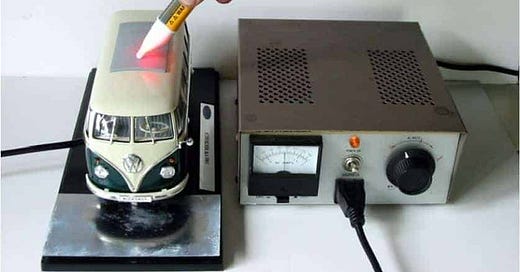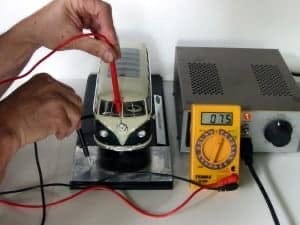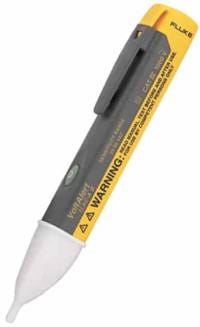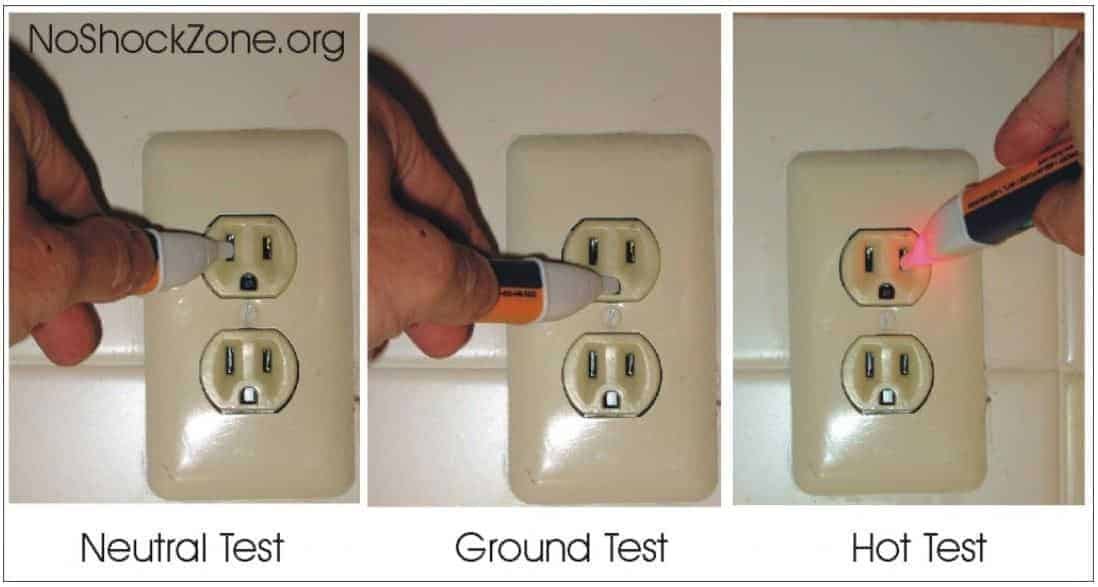Dear Readers,
Following is one of the most important articles I’ve ever written, and possibly ever will write. In the original version back in 2010 I introduced the concept to the RV industry of using a Non-Contact Voltage Tester to detect a dangerous hot-skin/contact-voltage.
Since then I’ve received hundreds of emails detailing how my readers found these hot-skin conditions on their RVs, saving their family from an electric shock and possible death by electrocution. Please read this article carefully as it could save your life.
The big picture
If you’ve been diligently reading this newsletter, you should at this juncture understand the basic concepts of what voltage is, how to read it with a meter and how to check the polarity of a campsite power outlet. For a refresher please reread Part 1: Electricity Basics
But why is this concept of voltage so important? Well, one of the greatest dangers of RVing, perhaps second only to a fire (which is really terrifying), is getting shocked and possibly electrocuted when touching the skin of your RV. And while some campers may have been injured by a bare wire on an extension cord or while poking their fingers in a power panel without proper precautions, the majority of RV shocks come when you least expect them, from the skin of your RV while simply opening the door.
Hot-skin voltage
An RV Hot-Skin Voltage occurs when the frame of the vehicle is no longer at the same voltage potential as the earth around it. This is usually due to an improper power plug connection at a campsite or garage AC outlet. Now, to be honest, I think the majority of campgrounds have properly wired and reasonably maintained power pedestals, but certainly there are instances where a campsite has outlets with reversed polarity or without proper grounding at all. However, I’ve seen enough dangerous “DIY” jobs to know that RV owners are also to blame for improper wiring of their own extension cords and 30-amp adapters.
The scenario could go something like this: You plug your RV into a 20-amp outlet in your garage just to charge the batteries and get the fridge cold. But the garage outlet has a missing ground since the house was built before 1960. Or maybe your extension cord has a broken off ground pin. That means you don’t have an EGC/Ground bond connecting your RV chassis to the power company service panel.
After that it just takes the right combination of circumstances such as a rainstorm to wet the ground around your RV and you touching the screen door with a damp hand while standing outside. That’s when you can get shocked or even electrocuted. The severity of the shock can vary from a mild tingle to stopping your heart, depending on how wet you and the ground are and the voltage of your RV skin.
But make no mistake – rather than the 30 or 40 volts of a high-resistance tingle, it’s possible to have the skin of your RV go to 120 volts with full current of the campsite pedestal with 20, 30 or even 50 amps available as fault current.
Insulation
The reason we don’t always notice this Hot-Skin condition until it’s too late is that an RV is basically a big metal frame sitting on rubber tires. And those tires act as electrical insulators just like the rubber surrounding the metal wire of your extension cord. That means that the skin of your RV can be electrically charged with 30, 60 or even 120 volts with no visual indication of the problem until you complete the connection to the earth with your hand. There’s no blue glow like in the movies, no sparks or hum. The hot-skin voltage just sits there silently and invisibly waiting for a fault path back to earth-ground.
Then, because your own body provides a conductive path to earth (remember the pipes between the water tanks in Part 1 of this series), current will flow through your body to the ground. How much fault current occurs is really the subject of another article, but if your hands and feet are wet your body becomes a 1,000-Ohm resistor connected from your hand on the door handle to your feet on the ground. This will allow more than 100 mA (milliamperes) of electrical current to flow through your heart from a 120-volt circuit.
How much current is dangerous?
Tests have shown that as little as 20 or 30 mA of 60-Hz current (what comes out of your electrical outlet) can cause your heart to go into fibrillation (essentially creating a heart attack). So you can easily get five times the current needed to kill yourself from a 120-volt outlet.
Note that 100 milliamps of current isn’t enough to trip a standard 20- or 30-amp circuit breaker, but it will trip a GFCI (Ground Fault Circuit Interrupt) as long as it’s been properly connected. But those GFCI breakers and outlets are only in the bathroom, kitchen and outside outlets of your RV, not the incoming 30 or 50 amp shore power connection – so check for Hot-Skin conditions before you get shocked.
Making a list, checking it twice…
What follows are two ways to determine if the skin of your RV has been electrified. One method involves using a voltmeter just like we learned about in Part 2 of this series, while the second method uses a non-contact AC tester like you see electricians use to check for live electrical outlets. Both methods are described below.
But be aware that even if you tested your RV when you made camp and found it safe from a Hot-Skin condition, that could change at any time if something happens to the campsite power after you’ve plugged in. If you feel even the slightest tingle from your RV, that’s the time to shut off the circuit breaker from the campsite pedestal, pull the plug, and get an electrician to double-check the outlet ground. Don’t bet your life on a faulty connection.
Using a meter
After you’ve tested the campsite outlet for proper polarity (Part 3 of this series), powered off the circuit breaker and connected your RV power plug, now it’s time to turn the circuit breaker back on and confirm that your RV is safe from a Hot-Skin voltage.
To use a standard digital voltmeter such as the one we learned about in Part 2 of this series, you’ll need to set it to measure AC voltage. Note that since a Hot-Skin condition will typically be less than 120 volts, the 200-volt or 750-volt AC setting (as pictured) will be fine.
Just like before, plug the black probe into the black COM connection on the meter and the red probe into the RED VOLTS connection on the meter. Remember, never plug into the 10-Amp connection, and never set the meter dial to measure amps or ohms. That’s for advanced testing only, and you’ll only blow out the meter’s fuse if you try to test for voltage that way.
Ready… Set… Test…
If you’re close enough to any metal going into the earth, such as the exterior of the pedestal power box or a metal water pipe, poke it firmly with the sharp tip of the black probe. You’ll need to punch through any rust or paint, so an exterior bolt or machine screw is usually a good choice. Now without touching the body of your RV with your hand, poke the skin of your RV with the sharp tip of the red probe. Again, this needs to make connection to the metal skin of your RV, so if you want to avoid making little holes in your paint job pick a spot like the trailer hitch or a chrome door knob.
Next, while both probes are making contact you should read very close to 0 (zero) volts. The National Electrical Code allows up to 3 volts between the ground and neutral conductors, and there can always be a few volts between neutral and actual earth ground, so up to 3 volts or so under load is expected and safe. If, however, you read 10 volts, 50 volts or 120 volts, that’s the time to back away from the RV, turn off the circuit breaker, pull the power plug and immediately get the campsite electrician to find out what’s wrong. If he tells you that 50 volts on the skin of your RV is fine, demand your money back, break camp and get out of there. Do not let your family or pets enter an RV with a Hot-Skin condition. Also, it’s a good idea to alert your local RV association that a campground has a dangerous power condition. That way you help the next RVer, too.
Using a non-contact tester
While a digital voltmeter is the gold standard method for testing Hot-Skin conditions, it must be used exactly right or it can give you a false sense of security. Therefore, perhaps the easiest and best way to check for an RV Hot-Skin is by using a $30 non-contact AC tester such as a Fluke VoltAlert. These testers look like a fat pen with a plastic tip and are available at hardware stores such as Lowe’s, or on Amazon.com. Most have a blinking light and beeper that makes noise when the tip is held near an energized circuit.
How do I know these things work? Well, I built a Hot-Skin simulator that can energize the body of an RV with any voltage from zero to 120 volts at the twist of a dial. I’ve energized everything from a microphone to an Airstream to find the best Hot-Skin testing methods. Yes, it’s a bit “Frankenstein,” but this gear allows me to see how well the various test methods work. And the Fluke VoltAlert seems to work very well for Hot-Skin conditions as low as 40 volts.
To test for an RV Hot-Skin just turn on the non-contact tester by pushing the power button quickly, which will begin to blink once every few seconds to show you it’s on. Then confirm the tester is working properly by poking it into a hot blade of the power outlet on the pedestal. It should beep at you and blink if all is well.
Now, gripping the tester firmly in one hand while standing on the ground, move the plastic tip until it’s touching anything metal around your RV. This could be an aluminum screen door, the exterior of an Airstream or the steel of the trailer hitch. With a non-contact tester you do not have to punch through the layer of paint, rust or plastic. If your RV has more than 40 volts on the skin, the VoltAlert will light up and start beeping at you, even from an inch or more away from the surface of the RV. See my desktop video of this test HERE.
Caveats
Here are a couple of warnings about using non-contact testers to check for Hot-Skin conditions: (1) These testers need to have your hand wrapped around them to sense the earth ground, so if you hold them with just the tips of your fingers it’s possible to get a false-safe reading. (2) Non-contact testers need your feet to be near the ground to know the actual earth potential, so if you’re standing on a fiberglass ladder they won’t read properly. (3) You need to verify that your NCVT is actually working by testing something you know is ON, before you test your RV. That way you know it hasn’t failed.
Additionally, since non-contact testers are looking for the voltage difference between your hand and the plastic tip of the probe, if you’re standing inside an RV with a Hot-Skin and you test your galley sink, they won’t indicate trouble when indeed there is. Therefore, always grip the non-contact tester firmly in your hand while standing on the ground outside your RV. And if your vehicle has as little as 40 volts of Hot-Skin potential, the tester should alert you of the danger even without physically touching your RV.
You can just slip your VoltAlert pen in your pocket and use it to quickly test any RV in the campground you might be visiting. It only takes a few seconds to test for a Hot-Skin problem this way, and you may save another RV owner’s life.
Outlets revisited
Since these non-contact testers are designed to check outlets for electrical power, they’re also a great way to confirm outlet polarity. If you remember what a typical AC outlet looks like, you can poke the VoltAlert into the tall neutral slot (no blink or beep), then the ground hole (no blink or beep) and finally the shorter hot slot (should blink and beep). It won’t tell you the exact voltage of the outlet like a voltmeter, but it will confirm if the polarity is correct and tell you if the ground connection has been floated and electrified by another RV with a short in its own wiring. This is pretty cheap insurance since you can never be too safe around electricity.
Quick tips
Perform a Hot-Skin test after you’ve checked campsite outlet polarity and voltages with a voltmeter.
Perform a Hot-Skin test every time you plug into a new campsite or home power outlet.
If you ever feel the slightest tingle or shock from your RV, avoid all contact, shut off and unplug from the AC power at the pedestal, and get professional help to determine the cause of the shock.
Even if you’ve stopped getting shocked from your RV because the ground is dry, the Hot-Skin problem has not fixed itself.
Be sure to properly maintain your RV electrical system and test all RV interior outlets for proper polarity and grounding.
Let’s play safe out there…. Mike












Thank you for the excellent article. Because of the following phenomena, "And if your vehicle has as little as 40 volts of Hot-Skin potential, the tester should alert you of the danger even without physically touching your RV." I believe your recommendation should be for a dual range NCVT , such as the Klein Tools NCVT2P, which can detect voltages as low as 12 VAC,. he NCVT-2 is (readily available from Amazon and many hardware stores). The Fluke NCVT mentioned in the article detects voltages beginning at 90 VAC.